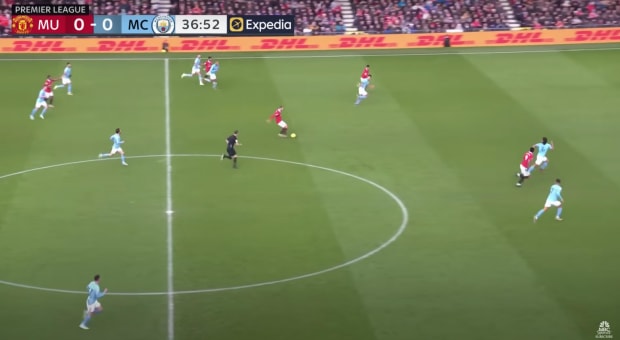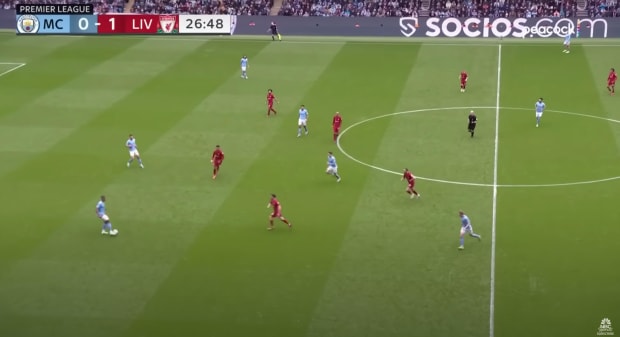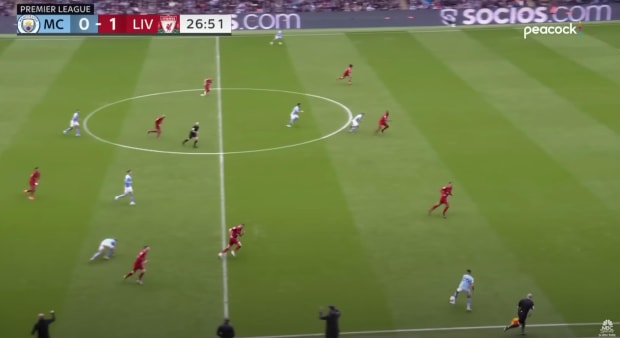Editor’s note: Manchester City won Saturday’s FA Cup final against Manchester United 2–1.
In the midst of its unbridled stretch of dominance in English football, it’s almost easy to forget Manchester City ran into a surprising roadblock on its way to its fifth Premier League title in the past six years.
A little over halfway through this 2022–23 league season, alarm bells were ringing at the Etihad. City had allowed two or more goals in eight of its first 29 matches in all competitions. Questions (perhaps comically so in hindsight) arose about whether wunderkind striker Erling Haaland and his barrage of goals actually made the team better. Sitting five points off first place and having just lost to rival Manchester United, manager Pep Guardiola declared the title race out of reach. “I don’t care about the Premier League or the Carabao Cup, we cannot win,” he said. The sky-blue machine looked surprisingly fallible.
So with the season seemingly in disarray, Guardiola, the master tinkerer, did what he does best. He made a slight tweak to a tactical evolution he himself had pioneered, and City rattled off a run of 25 matches without a loss that secured the league title and has it within arm’s reach of two more trophies. In a season defined by narrow margins, that one tweak has City poised to contend for a historic treble heading into Saturday’s FA Cup final.
The use of “inverted fullbacks” has become a fad of sorts among the Premier League’s top teams. Playmaking fullbacks who can slot into the base of a midfield and help play out of the back are valuable for teams that look to dominate possession and control the middle of the pitch. The origin of this tactical minutia, at least in its modern form, can be traced back to Guardiola in his time at Bayern Munich. In allowing legendary fullback Philipp Lahm to meander inside, it helped both in the build-up and in defensive transition against counterattack-minded Bundesliga teams.
Guardiola took the idea to City, where Kyle Walker and João Cancelo each provided different attributes that gave the side advantages in attack and defense as inverted fullbacks. From Week 1 of this season, however, the tactical idea seemed even more pronounced. After a season-opening 2–0 loss to City, West Ham manager David Moyes said his team wasn’t ready for just how narrow the fullbacks played.
“We found it hard to outnumber them in the middle of the pitch, then we found it difficult when they got it wide,” Moyes said.
But that defensive solidity wasn’t ever-present. City shipped three goals in a draw to Newcastle and two in a loss to Brentford before heading to Old Trafford in January. That 2–1 Manchester Derby loss exposed how City wasn’t strong enough in defensive transition against sides with talented wingers and control in the midfield.
From the start, United midfielder Christian Eriksen was clever off the ball, finding pockets of space that unlocked the City defense. In a moment of defensive transition, Eriksen found himself with acres of space in the middle of the pitch.

Photo courtesy of NBC Sports
Walker had stayed wide to try to win the ball off Marcus Rashford, and midfielder Rodri was well out of position when the ball found the Dane. Nobody within 15 yards of him, Eriksen played in Rashford, who couldn’t quite get his shot away before Ederson smothered it. But it was a warning shot from a United side that had its way in transition.

Photo courtesy of NBC Sports
In the end, City scored just once in the 2–1 loss, marking its fourth match of the previous five in which it scored one goal or fewer. It needed more stability in transition and it needed more ideas on the other end. So Guardiola took the inverted fullbacks to their next logical evolutionary step.
Two weeks later against Wolves, City started with three at the back. Walker and Cancelo were dropped. In their stead was 18-year-old right back Rico Lewis playing in a different role. He played up next to Rodri while in possession, controlling the pace of play and helping to stuff counterattacks before they began. Haaland netted a hat trick, Wolves were kept at an arm’s length from City’s goal and all seemed to be back on track in east Manchester.
What followed was a stretch of dominance that launched City to become favorites in the Premier League, the Champions League and the FA Cup. In the final 29 games of the season, City didn’t allow two or more goals one time. Guardiola continued to tinker with the exact lineup: Walker was reintroduced into the newly minted back three, while Cancelo was sent off to Bayern on loan after reportedly taking poorly to losing his starting spot.
Perhaps the most critical final tweak was moving center back John Stones up into Lewis’s spot. It’s another feather in the City staff’s developmental cap that a lanky center back could be molded into a holding midfielder. But Stones provided a veteran sense of match control from that position.
Stones playing in a double pivot next to Rodri in front of a back three meant there were five moving parts in the City attack to account for. It consistently created one-on-one opportunities for the team’s litany of tricky forwards.
Having gone 10 matches unbeaten, City went down a goal early to Liverpool in their early April matchup. But it didn’t take long to strike back. Stones, now the extra man in midfield, dragged Liverpool captain Jordan Henderson toward him just long enough to free Kevin De Bruyne to receive a pass from the back line.

Photo courtesy of NBC Sports
Seeing the danger of City’s midfield maestro going unmarked, Andy Robertson charged to defend, but De Bruyne played a clever first-time pass to Riyad Mahrez. One-on-one with the defender, Mahrez started a pretty move that was finished off by Julián Álvarez.

Photo courtesy of NBC Sports
Stones became the perfect poster child of this system: comfortable on the ball, aggressive defending in transition and more than willing to drop into the back line when necessary. In 10 games Stones has started in the midfield, City is 8-2-0 with a plus-25 goal differential. Guardiola’s side went on a 25-match unbeaten run to snatch the league title away from Arsenal in the final weeks of the season.
Two more matches stand in between Manchester City and English football immortality. If the most recent Manchester Derby is any indication, Saturday’s FA Cup final will be a hotly contested one.
When cup finals roll around, there’s always the possibility Guardiola will overthink his way into an unnecessary tweak to his side that stymies his own team. There should be no need for such a change this time—he’s already found the tactical solution he’s been looking for.







